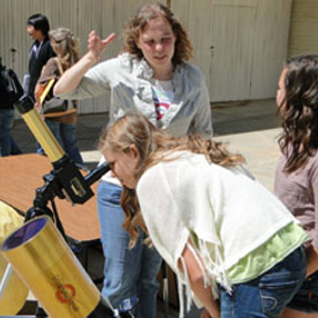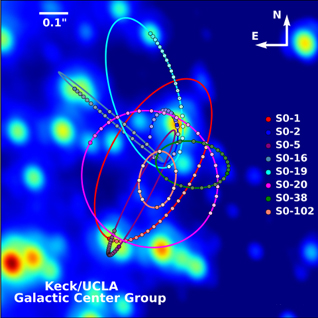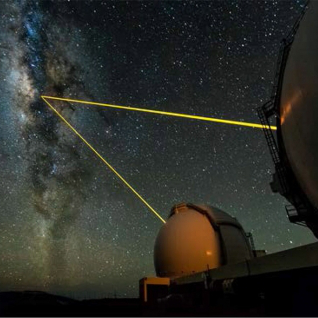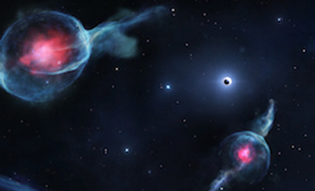Announcements
Video highlight: Andrea Ghez’s black hole research confirms Einstein’s Theory of Relativity
For the past 23 years Andrea Ghez, professor of physics and astronomy at UCLA, has been collecting data on stars that orbit black holes. She found that their motion provided an opportunity to test the fundamental laws of physics. “We asked how gravity behaves near a supermassive black hole and whether Einstein’s theory is telling us the full story. ”Einstein’s 1915 theory of general relativity holds that what we perceive as the force of gravity arises from the curvature of space and time. “In Newton’s version of gravity, space and time are separate, and do not co-mingle; under Einstein, they get completely co-mingled near a black hole,” she said. Ghez's research is the most detailed study ever conducted into the supermassive black hole and Einstein’s theory of general relativity.
Click the arrow at left to watch the video.

Education & Outreach
Inspiring the public & training the next generation of scientists. Read more...
Public News
Andrea Ghez gives her Nobel Prize lecture "From the Possibility to the Certainty of a Supermassive Black Hole."
About the P.I.
What drives the group’s Principal Investigator Prof. Andrea Ghez? Watch the video.
Frequently Asked Questions about Black Holes
What is a black hole?
Imagine an object. A sponge or a car. Or a star, our own Sun. You can make this object smaller by squeezing it. When you do that, the surface gravity gets stronger. The smaller the objects becomes, the stronger its gravitational pull gets. What happens if you squeeze the Sun so small that its radius is less than a couple of miles. Its surface gravity gets so large and powerful that nothing near this object can escape; not even light. This is a black hole.
How big is a black hole?
Astronomers use the term event horizon or Schwarzschild radius, which is the radius of an imaginary sphere that defines the point of no return. If an object crosses the event horizon, it falls into the black hole and can never return to the outside. More technically, the event horizon radius is defined as the radius at which the escape velocity of the black hole equals the speed of light. Thus even light cannot escape the gravitational field of the black hole if it crosses the event horizon.
Can any star become a black hole?
For most of its lifetime, a star stays intact. The gravity pulls everything inside the star inward but it does not collapse because this inward force is balanced by an outward force provided by the gas pressure from the high density and temperature in the center of the star. However, eventually the central region of the star runs out of fuel (whatever atoms that were fusing together to provide outward energy). What happens then? How stars evolve depends on their mass.
What happens if you fall into a black hole?
You probably do not want to go very near a black hole, but if you are so curious that you need to make a trip down there, here is what will happen. What happens to your body as you fall into a black hole isn't pretty. A tidal force applies to your body when you are falling into a black hole. The difference in acceleration between the head and feet could be many thousands of Earth gravities, and you will literally be ripped apart. Physicists call this phenomenon "spaghettification"!
How does light get bent by a black hole?
Any light that comes nearer than the event horizon gets caught and is not able to escape from the black hole's gravitational pull. The light that comes near but outside the event horizon does not get caught but its path is bent by the black hole's gravity. The starlight therefore appears distorted. This phenomenon has not been directly observed around any black holes yet, but we have seen examples around other massive astronomical objects.
What would hapen to the earth if the Sun became a black hole?
Fortunately, our Sun will never become a black hole. It is not massive enough to ever evolve into a black hole. The Sun will end its life as a white dwarf, in about 4.5 billion years from now. However, let's assume that the Sun is now replaced with a black hole of the mass equal to that of the Sun. The event horizon for one solar mass black hole is only 3km, so this hypothetical black hole would not affect the Earth and its orbit at all.



